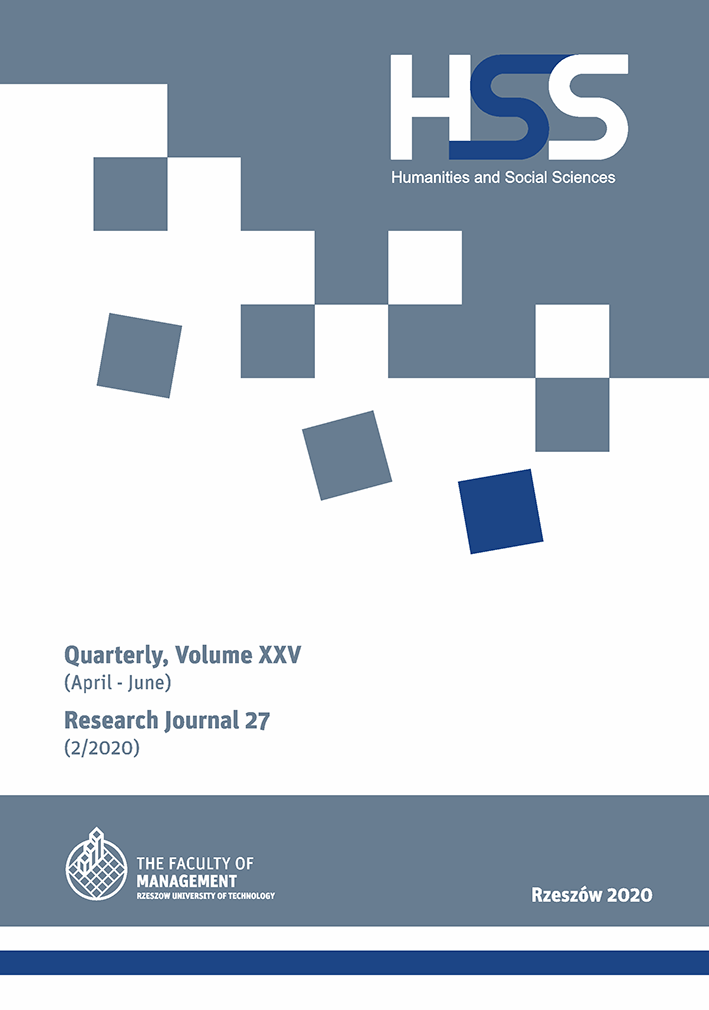Abstract
In the 20th century, a huge expansion of new information technologies began and in the 21st century, there was a rapid development of digital media and information technologies with people utilizing virtual reality to fulfill their needs. With the emergence of Artificial Intelligence there was a greater increase in activities that allowed technology to move in space, as well as to process symbolic information. However, now that humans have relationships with Artificial Intelligence, there is a need to modify the theory of social creation of reality. This will allow for a sociological analysis of social reality at the level of cyberspace.
References
Ambroży, N., Serafin, J. (2016). Rzeczywiste zastosowanie wirtualnego świata: metaanaliza badań na temat wirtualnej rzeczywistości (The real application of the virtual world: a metaanalysis of research on virtual reality) [In:] Gierszewski, J., Piwowarski, J., Kozicki, M.,Michalak, J., eds., “Kultura Bezpieczeństwa. Nauka – Praktyka – Refleksje” (Security Culture. Science – Practice – reflections), No. 22.
Baert, P., Carreira de Silva, F. (2013). Teorie społeczne w XX wieku i dzisiaj (Social theories in 20th century and today). Cracow: Publishing Zakład Wydawniczy Nomos.
Baudrillard, J. (2005). Pakt jasności. O inteligencji zła (Brightness pact. About the intelligenceof evil). Warsaw: Publishing Sic!
Bednarek, J. (2009). Teoretyczne i metodologiczne podstawy badań nad człowiekiem w cyberprzestrzeni (The theoretical and methodological basis of human research in cyberspace)
[In:] Bednarek, J., Andrzejewska, A., eds., Cyberświat: możliwości i zagrożenia (Cyberspace: opportunities and threats). Warsaw: Academic Publishing Żak.
Bednarek, J., Andrzejewska, A. (2009). Cyberświat – możliwości i zagrożenia (Cyberspace-opportunities and threats). Warsaw: Academic Publishing Żak.
Berger, P.L., Luckman, T. (1983). Społeczne tworzenie rzeczywistości (Social creation ofreality). Warsaw: Publishing PIW.
Blumer, H. (2008). Interakcjonizm symboliczny. Perspektywa i metoda (Symbolic interactionism. A perspective and the method). Cracow: Publishing Zakład Wydawniczy Nomos.
Bruno, M., Artificial Intelligence Quickly Entering Aerospace Manufacturing, Aviation Week 2018, Mar 27. Access on the internet: http://aviationweek.com/commercial-aviation/artificial-intelligence-quickly-entering-aerospace-manufacturing.
Chłopecki, A. (2018). Sztuczna Inteligencja – szkice prawnicze i futurologiczne (Artificial Intelligence – legal and futurological sketches). Warsaw: Publishing C.H.Beck.
Cellan-Jones, R. (2014). Stephen Hawking warns artificial intelligence could end mankind, BBC News, 2 December 2014. Access on the internet: https://www.bbc.com/news/technology-30290540.
Fehler, W. (2017). Sztuczna inteligencja – szansa czy zagrożenie? (Artificial intelligence – a chance or a threat). “Studia Bobolanum” (Bobolanum studies), Vol. 28, No. 3.
Flasiński, M. (2018). Wstęp do Sztucznej Inteligencji (Introduction to Artificial Intelligence). Warsaw: Scientific Publishing PWN.
Gurkaynak, G., Yilmaz, I., Haksever, G. (2016). Stifling artificial intelligence: Human perils. Computer Law&Security Report, No. 32(5).
Hałas, E. (1998). Interakcjonizm symboliczny (Symbolic interactionism) [In:] Kwaśniewicz, W., eds., Encyklopedia Socjologii (Sociology Encyclopedia), Vol. 1. Warsaw: Publishing Oficyna Naukowa.
Hałas, E. (1981). Symboliczny interakcjonizm – wielość orientacji a podstawy jedności perspektywy (Symbolic interactionism – a multiplicity of orientations and the basis for the unity of perspective). “Studia Socjologiczne” (Sociological Studies) No. 4.
—— (2012). Interakcjonizm symboliczny. Społeczny kontekst znaczeń (Symbolic interactionism. Social context of meanings). Warsaw: Scientific Publishing PWN.
Kluszczyński R.W. (2005). Światy możliwe – światy wirtualne – światy sztuki. Fragmenty teorii doświadczenia rzeczywistości wirtualnej (Possible worlds – virtual worlds – worlds of art. Fragments of the virtual reality experience theory) [In:] Ostrowicki, M., ed., Estetyka. Estetyka wirtualności (Aesthetics. Aesthetics of virtuality). Cracow.
Lech, A. (2013). Społeczne konstruowanie rzeczywistości obiektywnej (Social construction of objective reality). “Zeszyty Naukowe Politechniki Śląskiej, Seria: Organizacja i Zarządzanie” (Scientific Journals of Silesian University of Technology, Series: Organization and Management) Journal. 65, No. 1897.
Leśniak-Moczuk, K., Moczuk, E. (2002). Podstawy socjologii i psychologii społecznej (Basics of sociology and social psychology). Rzeszów–Przemyśl: Publishing Wyższa Szkoła Administracji i Zarządzania w Przemyślu.
Manterys, A. (2008). Sytuacje społeczne (Social situations). Cracow: Publishing Zakład Wydawniczy Nomos.
Manterys, A., Mucha, J., eds. (2010). Nowe perspektywy teorii socjologicznej. Wybór tekstów (New perspectives of sociological theory. Selected texts). Cracow: Publishing Zakład Wydawniczy Nomos.
Miczka-Pajestka, M. (2014) Między rzeczywistością realną i wirtualną – komentarz do problematyki „bycia między” (Between real and virtual reality – a commentary to the problem of "being in between”). Świat i Słowo (The World and the word). Filologia – Nauki społeczne – Filozofia – Teologia (Philology – Social Sciences – Philosophy – Theology), No. 1(22).
Napora, E. (2008). Wirtualny świat nieograniczoną możliwością rozwoju jednostki czy drogą donikąd (Virtual world with unlimited possibilities of individual development or the road to nowhere). “Podstawy Edukacji” (Educational Basis), No. 1.
Nian, L.P., Kuo Chuen, D.L. (2015). Introduction to Bitcoin [In:] Kuo Chuen, D.L., eds., Handbook of Digital Currency. Bitcoin, Innovation, Financial Instruments, and Big Data. San Diego: Academic Press.
NIST – National Institute of Standards and Technology, NIST Will Hold Public Workshop on Oct. 16, 2018. Access on the internet: https://www.nist.gov/news-events/news/2018/09/department-commerce-launches-collaborative-privacy-framework-effort.
O’Callaghan J. (2018). The cyborg cockroaches that are fitted with a mind controlled device. Access on the internet: https://www.dailymail.co.uk/sciencetech/article-2980828/The-cyborg-cockroaches-fitted-mind-control-device-used-explore-disaster-zones.html.
Rawski D., Szadura P., Laskowski M. (2012). Layar – wirtualna rzeczywistość drogą dostworzenia inteligentnego miasta (Layar – a virtual reality by the way to creating a smart city). „Zeszyty Naukowe Uniwersytetu Szczecińskiego” (Scientific Journals of Szczecin University), No. 721, Studia Informatica (Informatica Studies), No. 29.
Siuda P. (2006). Społeczności wirtualne. O wspólnotowości w społeczeństwie sieciowym (Virtual communities. About community in a network society) [In:] Sokołowski, M., red., Oblicza Internetu. Internet w przestrzeni komunikacyjnej XXI wieku (The face of the Internet. Internet in the communication space of the 21st century), Elbląg: Publishing Państwowa Wyższa Szkoła Zawodowa w Elblągu.
Turner, J.H. (1985). Struktura teorii socjologicznej (The structure of sociological theory). Warsaw: Scientific publishing PWN.
—— (2012). Struktura teorii socjologicznej (The structure of sociological theory). Warsaw: Scientific publishing PWN.
Winston, P.H. (1992). Artificial Intelligence. New York: Addison Wesley Publishing Company.
Wolpaw, J.R., Birbaumer, N., Heetderks, W.J., McFarland, D.J., Peckham, P.H., Schalk, G.,
Donchin, E., Quatrano, L.A., Robinson, C.J., Vaughan, T.M. (2000). Brain – Computer Interface Technology: A Review of the First International Meeting. “Idee Transactions on Rehabilitation Engineering”, Vol. 8, No. 2.
Virilio, P. (2006). Bomba informacyjna (Information bomb). Warsaw: Publishing: Sic!


